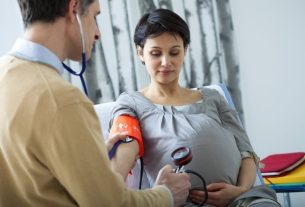HIV transmission can happen through sexual intercourse without a condom, sharing needles and syringes, donating blood or through breastfeeding.
This is because the HIV virus can be present in the body fluids of people infected with the virus, such as semen, vaginal fluids, breast milk, blood or pre-ejaculatory fluids, for example.
Therefore, to avoid transmission of the virus, it is important to use a condom in any sexual relationship and avoid sharing syringes, for example. However, if HIV is suspected, you should consult an infectious disease specialist to take tests and start treatment with antiretrovirals. See how the HIV test is performed and how to understand the result.

How transmission happens
The main forms of HIV transmission are:
1. Sexual intercourse without a condom
Sexual intercourse without a condom with an HIV-infected person is the main route of transmission of the virus, and can occur during intimate contact, especially anal and vaginal.
This is because HIV is present in body fluids, such as semen or vaginal secretions, and during sexual intercourse it is possible for small lesions to occur in the genital mucosa, increasing the risk of infection.
Furthermore, although it is rare, HIV can also be transmitted through oral sex, especially if there is a sore in the mouth, such as a cold sore, for example.
How to prevent: use condoms, such as male or female condoms correctly, whenever you have sexual intercourse, vaginal, anal or oral. Furthermore, another form of prevention is sexual abstinence or pre-exposure prophylaxis (PrEP) in people at increased risk of coming into contact with the virus. See how PrEP is done.
It is also important to treat sexually transmitted infections (STIs) if you have been diagnosed with an STI, as not treating them increases the risk of HIV infection.
2. Sharing needles or syringes
Sharing needles and syringes is also one of the most frequent ways of transmitting HIV, as these materials come directly into contact with blood.
Thus, once the virus is present in the blood, if the first person who used the needle or syringe is infected, they can easily pass the virus to the next person.
How to prevent: not share needles, syringes or other drug or medication injection devices, or not use injectable drugs.
Furthermore, people who frequently need to use needles or syringes, such as diabetics, should always use new, sterile needles and syringes for each application, in original packaging and within the expiration date.
3. Sharing sharp objects
Sharing objects, such as razors or nail clippers, for example, used by an HIV-infected person, is also a form of HIV transmission.
This is because these objects can have small amounts of blood transmitted to other people.
Additionally, using contaminated surgical instruments that are not properly sterilized, or sharing toothbrushes, can also increase the risk of HIV transmission.
How to prevent: Do not share shaving or shaving blades, nail pliers, razors or toothbrushes. Furthermore, when performing a surgical procedure, you must ensure that the site is regularized and inspected for sterilization practices.
4. Vertical transmission from mother to child
Vertical transmission is the transmission of the HIV virus from mother to child, which can happen during pregnancy, childbirth or breastfeeding.
This transmission is more frequent in women who have not been diagnosed with the HIV virus and/or have not received adequate treatment in accordance with the doctor’s instructions.
How to prevent: correctly take treatment with antiretrovirals that are safe to use during pregnancy, to reduce the viral load and reduce the chances of passing the virus to the fetus or newborn.
In addition, a cesarean section may also be indicated to reduce the chances of contact with blood during birth, as well as avoiding breastfeeding so that the baby does not contract the virus through breast milk. It may also be recommended to give the newborn the antiretrovirals recommended by the doctor until the 6th week of life, to prevent HIV infection.
5. Organ transplant or blood donation
Although extremely rare, due to increased security and evaluation of samples in specialized laboratories, the HIV virus can also be transmitted to people who receive organs or blood from another person infected with HIV.
This risk is greater in less developed countries and with fewer biosafety and infection control standards.
How to prevent: Currently, blood is tested for the presence of HIV viruses by laboratories before carrying out a blood transfusion or organ donation, so that it can be done safely, preventing HIV infection
6. Contact with contaminated blood or secretions
Contact with blood or secretions contaminated with HIV can occur mainly in people who work in hospitals, such as doctors or nurses, accidentally, when dressing wounds, performing surgery or giving injections or collecting blood.
However, it can also occur in people who work in laboratories collecting contaminated blood or secretions or laboratory analysis.
How to prevent: use gloves to handle wounds, perform surgeries, apply injections, collect blood or body fluids from people infected with HIV and adopt good laboratory practices, in order to avoid accidents and HIV infection.
How you can’t get HIV
Although there are several situations in which the HIV virus can be transmitted, due to contact with bodily fluids, there are others that no pass the virus, such as:
- Being close to someone with HIV, greeting them with a hug or a kiss;
- Intimate intercourse and masturbation with a condom;
- Use of the same dishes, cutlery and/or glasses;
- Harmless secretions such as sweat, saliva or tears;
- Use of the same personal hygiene material such as soap, towels or sheets.
HIV is also not transmitted through insect bites, through the air or through pool or sea water. Find out more about HIV.
How to reduce the risk of HIV infection
In addition to forms of prevention, other measures can help reduce the risk of HIV infection, taking antiretroviral treatment recommended by your doctor or encouraging your partner who has HIV infection to take the correct treatment.
This is because when treated correctly with antiretrovirals, it helps to reduce the viral load until it is undetectable, which significantly reduces the chance of HIV transmission, but does not eliminate it.
Furthermore, if the person has had sexual intercourse without a condom or accidents with needles or sharp materials, post-exposure prophylaxis (PEP) should be taken, with antiretroviral medications, as indicated by the infectious disease specialist, to prevent the multiplication of the HIV virus in the organism, its entry into cells and the development of AIDS. Find out how post-exposure prophylaxis is carried out.
Taking care of your health has never been easier!



